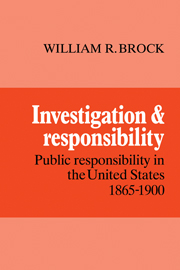Book contents
- Frontmatter
- Contents
- Dedication
- Preface
- 1 Public responsibility
- 2 Theory and practice
- 3 Public responsibility and the law
- 4 The charities of the State
- 5 The boards of public health
- 6 The bureaus of labor statistics
- 7 The railroad commissions
- 8 Toward the future
- Appendix 1 State agencies: some representative samples
- Appendix 2 Checklist of reports issued by boards of state charities, boards of public health, bureaus of labor statistics, and railroad commissions, 1865–1900
- Essay on sources and historiography
- Bibliography
- Index
6 - The bureaus of labor statistics
Published online by Cambridge University Press: 03 May 2010
- Frontmatter
- Contents
- Dedication
- Preface
- 1 Public responsibility
- 2 Theory and practice
- 3 Public responsibility and the law
- 4 The charities of the State
- 5 The boards of public health
- 6 The bureaus of labor statistics
- 7 The railroad commissions
- 8 Toward the future
- Appendix 1 State agencies: some representative samples
- Appendix 2 Checklist of reports issued by boards of state charities, boards of public health, bureaus of labor statistics, and railroad commissions, 1865–1900
- Essay on sources and historiography
- Bibliography
- Index
Summary
The nineteenth century was the first age of statistics in Great Britain and the United States. The new era dawned with the first federal census in 1790 and the first British census in 1801, but as first conceived the purpose of enumeration was very limited. In the United States the primary motive was to obtain exact figures on which to base the apportionment of seats in the House of Representatives; in Britain the demand for figures reflected anxiety about the burden of poor rates and controversy over whether the population was rising, declining, or merely shifting.
Once the census was instituted it became comparatively easy to add new questions to the enumeration, and to subject the figures to more sophisticated analysis. In Britain, in the 1830s, the registration of births, deaths, and marriages became compulsory, and before long the death rate was recognized as the standard by which the statutory requirement for the establishment of a local board of health could be determined. Private insurance companies had run somewhat ahead of governments in working out their own tables of life expectancy, but by 1850 there was accumulating evidence on the incidence of disease, on accidents, wages, cost of living, and poverty.
The counting of heads had been traditionally associated with some new and probably unpleasant purpose of government: taxation, the raising of armies, or the regulation of trade. In the nineteenth century it became increasingly associated with economic and social change.
- Type
- Chapter
- Information
- Investigation and ResponsibilityPublic Responsibility in the United States, 1865–1900, pp. 148 - 184Publisher: Cambridge University PressPrint publication year: 1984



